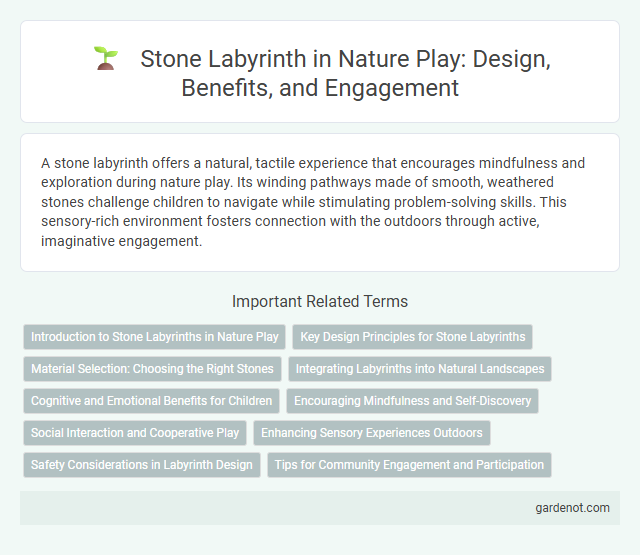A stone labyrinth offers a natural, tactile experience that encourages mindfulness and exploration during nature play. Its winding pathways made of smooth, weathered stones challenge children to navigate while stimulating problem-solving skills. This sensory-rich environment fosters connection with the outdoors through active, imaginative engagement.
Introduction to Stone Labyrinths in Nature Play
Stone labyrinths in nature play create immersive environments that promote mindfulness, spatial awareness, and problem-solving skills. These intricate patterns of carefully arranged stones invite exploration and encourage children to engage physically and mentally with natural materials. Incorporating stone labyrinths into outdoor play settings enhances sensory experiences and fosters a deeper connection to the natural world.
Key Design Principles for Stone Labyrinths
Key design principles for stone labyrinths emphasize organic shapes and natural materials to blend seamlessly into outdoor environments, enhancing the sensory and exploratory experience for users. Pathways should be wide enough for safe navigation and designed to encourage mindfulness, with stones placed to create a contemplative flow without sharp edges or abrupt turns. Incorporating varied textures and subtle elevation changes supports accessibility while fostering engagement through tactile interaction and visual intrigue.
Material Selection: Choosing the Right Stones
Selecting the right stones for a stone labyrinth involves prioritizing durability, safety, and natural aesthetics to create an engaging play environment. Granite, sandstone, and limestone are popular materials due to their weather resistance and textured surfaces that provide natural grip. Properly sized and shaped stones prevent tripping hazards while blending harmoniously with the surrounding landscape.
Integrating Labyrinths into Natural Landscapes
Stone labyrinths seamlessly blend into natural landscapes by using locally sourced rocks that harmonize with the surrounding environment. These labyrinths promote mindfulness and exploration, inviting visitors to engage with nature through tactile and visual stimuli. Integrating labyrinths into diverse ecosystems enhances ecological awareness while providing a serene, meditative space within outdoor settings.
Cognitive and Emotional Benefits for Children
Stone labyrinths in nature offer significant cognitive and emotional benefits for children by stimulating problem-solving skills and enhancing spatial awareness through hands-on exploration. The tactile experience of navigating the labyrinth promotes mindfulness and emotional regulation, fostering patience and reducing stress. Engaging with these natural structures also supports creativity and resilience, contributing to overall mental well-being during outdoor play.
Encouraging Mindfulness and Self-Discovery
Stone labyrinths foster mindfulness by guiding individuals through slow, deliberate movements that enhance focus and present-moment awareness. The intricate patterns encourage self-discovery as walkers engage in reflective thought and emotional processing within a natural setting. This meditative practice nurtures mental clarity and inner peace, promoting well-being through connection with the environment.
Social Interaction and Cooperative Play
Stone labyrinths encourage social interaction by inviting children to navigate pathways together, fostering communication and teamwork. Cooperative play emerges as participants collaborate to find routes and solve spatial challenges, enhancing problem-solving skills and group dynamics. These shared experiences cultivate empathy and collective creativity in natural play environments.
Enhancing Sensory Experiences Outdoors
Stone labyrinths enhance sensory experiences outdoors by engaging touch, sight, and spatial awareness through their textured surfaces and intricate pathways. Walking barefoot along cool, uneven stones stimulates proprioception and balance, deepening connection to the natural environment. The labyrinth's rhythmic patterns promote mindfulness and relaxation, encouraging immersive interaction with surrounding sounds and scents.
Safety Considerations in Labyrinth Design
Stone labyrinths designed for nature play must prioritize safety by using smooth, non-toxic stones with no sharp edges to minimize injury risk. Proper spacing between stones ensures stable footing and reduces tripping hazards, especially for young children. Incorporating clear pathways and visible boundaries enhances safe navigation while allowing an engaging exploration experience.
Tips for Community Engagement and Participation
Stone labyrinths provide an interactive and meditative space that encourages community members to connect through shared experiences and collaborative maintenance. Organizing guided walks, labyrinth-building workshops, and storytelling sessions can foster local involvement and deepen appreciation for natural play environments. Encouraging schools and neighborhood groups to participate in design and upkeep strengthens community bonds and promotes environmental stewardship.
Stone labyrinth Infographic

 gardenot.com
gardenot.com